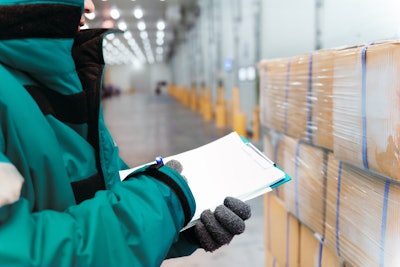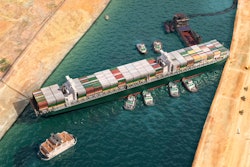
Amidst the uncertainties of the “New Normal,” such as the Suez Canal incident in 2021 that caused disruptions across regions and industries, global commodities shortages due to the Coronavirus disease (COVID-19) pandemic and geopolitical disruptions impacting the supply chain, companies are quickly shifting to active monitoring technologies to intervene on-time, rescue shipments at risk or buffer forecasted inventory shortfalls days before delivery commitments are due.
According to the International Trade Administration, worldwide losses in the food industry total more than $750 billion each year. With tight margins and supply chain stressors, no company can afford the financial or reputational damage that comes with the trickle-down impacts of ruined temperature-sensitive products.
What was once taken for granted, a smoothly functioning supply chain, is now at the forefront of discussions across industries. The complexities associated with the distribution of COVID-19 vaccines have highlighted the advances in cold chain technology; cold storage infrastructure is witnessing the proliferation of new and next-generation technologies to complement various aspects of the cold chain, including monitoring.
Also, the “New Normal” of online deliveries for food means that cold storage and transportation to provide fresh groceries and safe medicines are in ever-increasing demand.
What’s driving the shift?
One of the biggest challenges of any supply chain is preventing product waste, damage and loss. When transporting food and beverages, the items being shipped are not just time-sensitive, but also condition-sensitive. Cold chain ensures that perishable products are safe and of high quality at the point of consumption. Failing to keep products at the correct temperatures can result in textural degradation, discoloration and microbial growth. In the case of foods or medicines that are shipped or stored outside of specified temperature parameters, the safety of consumers may be at risk.
Manufacturers and shippers responsible for transporting food items are committed to ensuring quality and authenticity to meet food safety guidelines. Meeting such quality standards needs strict supervision at every stage, while at warehouses or at vendor facilities and in transit.
Today’s customer is further driving demand for auditability and unmatched Service Level Agreements (SLAs), like Amazon’s same-day delivery experience, while demanding transparency throughout the journey from farm to fork to ensure authenticity and quality.
For this reason, cold chain logistics rely heavily on technology to securely audit the transportation from start to finish. However, cold chain tracking technology has been mostly passive, using data loggers - a compact, battery-powered device equipped with an internal microprocessor. This level of tracking provides a temperature trace record throughout the journey, but cannot prevent spoilage or contamination that can result from outages, inventory shortages and unpredictability.
New technology and logistics processes are enabling faster and more efficient methods of cold chain logistics. With active cold chain visibility technologies, products are monitored and tracked throughout every step of the cold supply chain.
Benefits of best-in-class active monitoring technologies
Active monitoring technologies such as real-time cold chain monitoring sensors are used to provide an uninterrupted audit trail of refrigerated production, storage and distribution processes. These sensors are offered by Internet of Things (IoT) companies, but that still doesn’t necessarily add much value unless the data tells the full story and is prescriptive in nature to drive an optimal course of action without delay in actionability.
For an active cold chain monitoring technology to be actionable, live contextual warnings built on active IoT cold chain sensor-driven data are required. By considering all relevant factors, this type of analysis generates recommendations for next steps. For example, the alert needs to mention to the supply chain execution team when there is an increase in outside temperature and that it is a high priority to intervene to prevent any damage or risk to the products being transported.
The actionability is further enhanced when it can inform supply chain planners of any setbacks, such as when an airport is not suitable for shipping on time or in full, due to uncertainties in temperature excursions and estimated time of arrival, compared to other airports that are more convenient to deliver products on time and safely.
Such active cold chain technologies that offer prescriptive signals and analytics are especially helpful in ensuring less food wastage, sustainability and better availability and auditability of pharmaceutical products like COVID-19 vaccines, as the world fights newer variants of the virus.
Active cold chain monitoring technology has proven its benefit for live logistics execution insights and stock volatility during these uncertain times, where on-time and complete deliveries become increasingly important for companies to retain and acquire new customers. For example, if you know that a consignment is three days away from delivery to a customer and that it will not arrive safely, an alternate delivery can be arranged within those three days to meet the on-time/in-full (OTIF) commitment.
Additionally, risk is reduced with active cold chain monitoring technologies and prescriptive signals by knowing ahead of time the impact to a node, a distribution lane or a customer’s order, especially if the visibility is at a product or item level.
Cold chain logistics visibility is not just about cost savings and efficiency, but about positively transforming organizations and contributing to increased customer support and satisfaction.
While there are continuous complexities that constantly arise during the cold chain process of moving temperature sensitive materials, investing in an active monitoring technology is the first step toward the autonomous cold chain of the future, in which live data drives system and human decisions.
In summary
The safety, integrity, quality and usability of goods and products depend on good cold chain management. Modern cold chain management using the latest in thermal packaging, temperature tracking and monitoring helps protect temperature-sensitive products. Whether it's keeping food chilled or vaccines protected, cold chain management and logistics keep the supply chain of vital goods and products operating smoothly.
If the recent year has taught us anything, it is to prepare for the unexpected in supply chain management, especially with cold chains that have an additional element of condition to maintain. Thus, the more you know about every step of your supply chain in multiple dimensions, the greater the likelihood you’ll weather both day-to-day and disruptive events successfully - key to building resilience, customer delight, leadership in the market and sustainability.
















